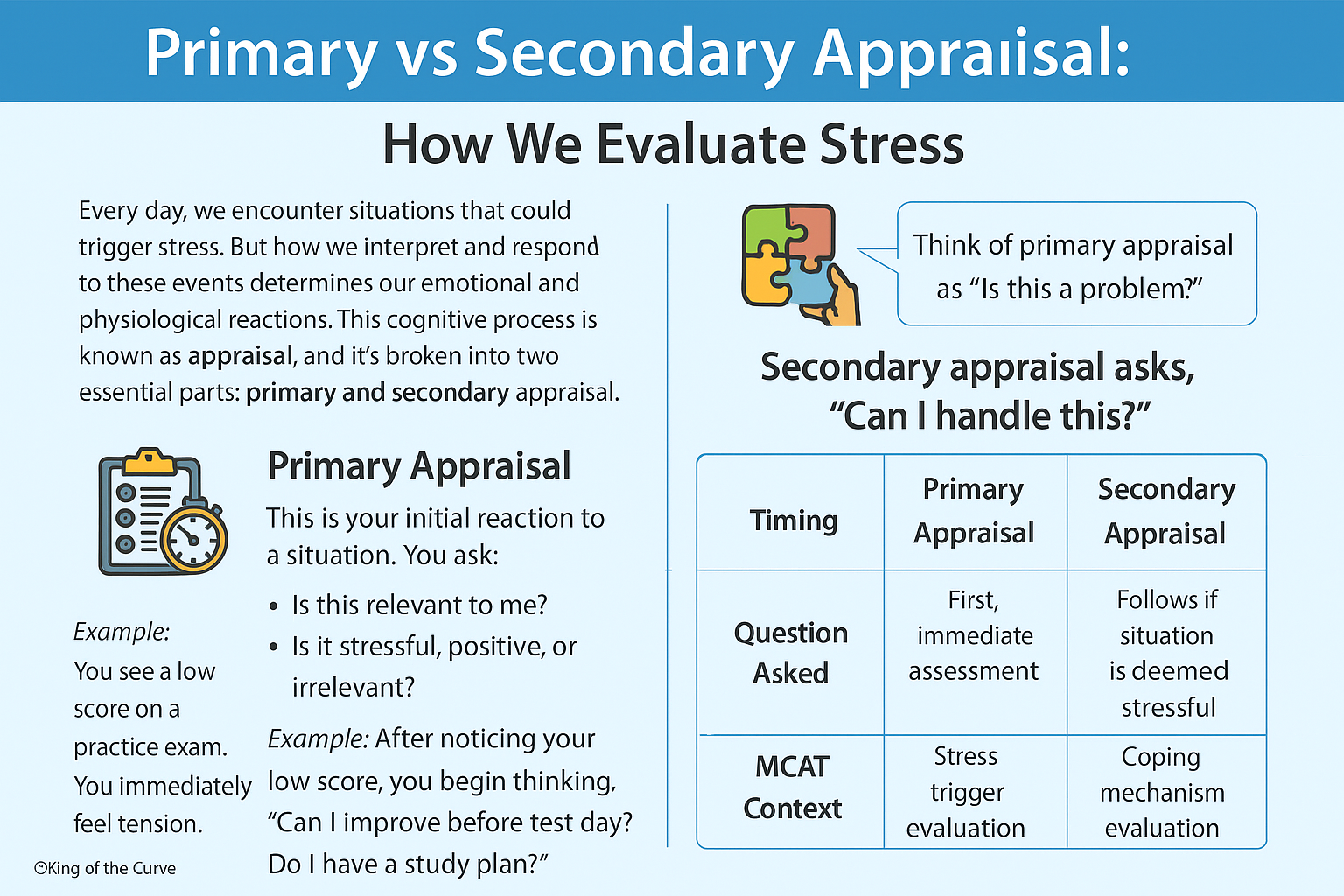
🧠 Sociocultural Model of Emotions: What the MCAT Wants You to Understand
Learn how emotions are shaped by culture, relationships, and social context. Master the sociocultural model for the MCAT Psychology section with visual aids.

🧠 How Your Brain Judges Stress: Appraisal Theory for the MCAT and NCLEX
Understand primary and secondary appraisal in stress theory. Learn how to apply this key concept on the MCAT and NCLEX with examples and visuals.

💡 Peer Pressure and Decision-Making: What Every Premed Needs to Know
Learn how peer pressure impacts decisions on the MCAT & NCLEX. Boost your prep with King of the Curve’s visuals, ethics insights, and study tips.

💡 Rational Choice Theory: Decision-Making in Social Behavior
Learn what Rational Choice Theory is and how it explains human behavior through decision-making. High-yield for MCAT psych/soc and real-world applications in economics and sociology.

💓 Jugular Venous Pulse (JVP): Waves, Mnemonics, and Clinical Clues
Understand the JVP waveform, its clinical interpretation, and how to master the a, c, and v waves for USMLE Step 1 and Step 2 CK.

🧬 DNA vs. RNA — Key Differences You Must Know
Learn the structural and functional differences between DNA and RNA for the DAT. Compare nitrogenous bases, sugar types, strand number, and roles in biology.

🧠 Marfan Syndrome for USMLE Step 1: Fibrillin-1 Mutation, Tall Stature, and Aortic Aneurysms
Master Marfan Syndrome for Step 1. Learn its genetic basis, clinical findings like aortic dissection and lens dislocation, and key features of FBN1 gene mutation.

🚨 NCLEX Sepsis Progression Guide: From SIRS to Septic Shock
Learn how to recognize and manage SIRS, sepsis, severe sepsis, and septic shock. NCLEX visuals, mnemonics, and interventions.

🧠 Primary vs Secondary Appraisal: How We Evaluate Stress
Learn the difference between primary and secondary appraisal in stress psychology. Understand how we evaluate threats and plan coping strategies—perfect for MCAT prep.

💧 Countercurrent Mechanism: How the Nephron Concentrates Urine (Made Simple)
Learn how the nephron’s countercurrent multiplier and exchanger concentrate urine. Includes visual breakdowns and Step 1-style integration for renal physiology.

🔬 Acids and Bases — Definitions, Strength, and pH Strategy
Master acid-base theory for the DAT. Learn Arrhenius, Brønsted-Lowry, and Lewis definitions, strong vs. weak acids, and how to calculate pH and pOH.

🧠 Oxyhemoglobin Dissociation Curve for USMLE Step 1: Right vs Left Shifts and Clinical Clues
Master the oxyhemoglobin dissociation curve for Step 1 — learn what causes right and left shifts, how they affect oxygen delivery, and how to recognize key clinical associations.

🦠 NCLEX Sepsis Guide: SIRS, Sepsis, Septic Shock & Nursing Priorities
Learn to recognize sepsis progression for the NCLEX. Covers SIRS, severe sepsis, septic shock, and evidence-based interventions.

⚖️ Metabolic Acidosis: Understanding AG, HAGMA, and NAGMA
Learn to differentiate high vs. normal anion gap metabolic acidosis using visual charts and mnemonics. Perfect for USMLE, NCLEX, and clinical mastery.

💩 Osmotic vs. Secretory Diarrhea: Key Differences, Mnemonics, and Clinical Vignettes
Differentiate osmotic vs. secretory diarrhea with easy mnemonics, pathophysiology insights, and USMLE-style vignettes. A must-know GI concept for Step 1/2 CK.

🌊 Water’s Unique Properties – Hydrogen Bonds, Cohesion & DAT Relevance
Understand the special properties of water tested on the DAT, including hydrogen bonding, cohesion, adhesion, surface tension, and temperature regulation.

🧠 Granuloma Formation for USMLE Step 1: Immune Mechanism, Histology, and Disease Associations
Understand the immune mechanism and pathology behind granulomas. Learn the difference between caseating and non-caseating types, and their role in TB, sarcoidosis, Crohn’s, and more.

🧪 NCLEX Metabolic Acidosis: AG, HAGMA & NAGMA Made Easy
Learn how to identify and calculate anion gap (AG), HAGMA, and NAGMA with visuals and mnemonics. NCLEX practice tips included.

🧠 Groupthink: When Agreement Overrides Logic
Understand groupthink and how it influences group decisions. Learn its key traits, exam relevance, and how to avoid blind conformity—perfect for MCAT and psych review.

🧠 The Rule of 9s: Burn Assessment Made Easy for Medical Exams
Master the Rule of 9s for burn assessment in adults, including TBSA calculations and emergency management pearls. Perfect for USMLE Step 2 CK and rotations.
